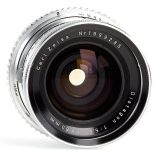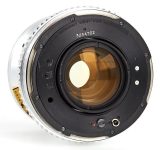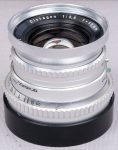Carl Zeiss Distagon 60mm F/5.6 C
Wide-angle prime lens • Film era • Discontinued
- Announced:
- · 1957
- Production status:
- ● Discontinued
- Country of design:
- · FRG (Federal Republic of Germany)
- Original name:
- · Carl Zeiss Distagon 1:5,6 f=60mm
- Class:
- · Slow 6x6 medium-format wide-angle prime lens
- · Professional model (Top class)
- System:
- · Hasselblad V (1957)
Abbreviations
| C | A lens with Compur shutter. |
Specification
| Optical design: | |
| Medium format 6x6 | |
| 60mm | |
| F/5.6 | |
| <No data> | |
| Hasselblad V [74.9mm] | |
| 66.5° | |
| Diaphragm mechanism: | |
Diaphragm type: | Automatic |
Aperture control: | Aperture ring (Manual settings only) |
| Built-in leaf shutter: | |
Type: | Mechanical Synchro-Compur |
Range of shutter speeds: | 1 - 1/500 + B |
Self-timer (V): | Yes |
Shutter speed control: | Shutter speed ring |
Cross-coupling control: | Catch for disengaging cross-coupling |
Flash sync mode: | M & X sync |
Flash sync terminal: | Yes |
| Focusing: | |
| 0.55m | |
| <No data> | |
Focusing modes: | Manual focus only |
Manual focus control: | Focusing ring |
| Physical characteristics: | |
| <No data> | |
| <No data> | |
| Accessories: | |
| <No data> | |
| <No data> | |
| <No data> |
Source of data
- Own research.
Carl Zeiss C series
The first generation of Carl Zeiss lenses with a built-in leaf shutter, introduced in 1957.
- Synchro-Compur leaf shutter with self-timer (V);
- Fully synchronized for M- and X-settings so that you can work with flash at all shutter speeds;
- Aperture and shutter speed are cross-coupled by default but can be set independently for complete creative control;
- Originally matt-chromed, all C lenses were supplied in black trim from 1969 to 1981;
- T* multi-coated from 1973 (30-80mm focal length range), 1974 (all focal lengths).
From the editor
A rare wide-angle prime lens introduced with the Hasselblad 500C in 1957. Supposedly has the same optical design as the version for Hasselblad 1600F/1000F cameras.
Version with distance scale in feet/inches has the closest focusing distance of 21 inch.
At some point it was discontinued in favor of the F/4 model, which was produced for a very short time and was quickly replaced by the F/3.5 model.
Frequently asked questions
What does the Carl Zeiss lens designation "Distagon" mean?
The Distagon retrofocus design was specially developed to enable the use of extreme wide-angle lenses on SLR cameras. As the back focal distance can be made considerably longer than the lens focal length, it allows the motion of the reflex finder mirror in the free space between the last lens element and the film plane. The Distagon lenses - characterized by extraordinary speed and angle of view - provide remarkably good correction of all aberrations and thus excellent image quality. Through the use of floating lens elements (FLE) it has been possible to achieve high image quality and field flatness even in the close focusing range. The Distagon CFi 3.5/30 mm fish-eye lens features the widest diagonal angle of view in medium format - 180°. / Source: Hasselblad literature /
Other wide-angle prime lenses in the Hasselblad V system
| ■Hasselblad V mount (12) | |||||||||
| Carl Zeiss Distagon [T*] 50mm F/4 C | A | 7 - 7 | 0.50m | ● | |||||
| Carl Zeiss Distagon T* 50mm F/4 CF | A | 7 - 7 | 0.50m | B60 | 1982 ● | ||||
| Carl Zeiss Distagon T* 50mm F/4 FLE CF | A | 9 - 8 | 0.50m | B60 | 1989 ● | ||||
| Carl Zeiss Distagon T* 50mm F/4 CFi | A | 9 - 8 | 0.50m | B70 | 1998 ● | ||||
| Carl Zeiss Distagon T* 50mm F/4 ZV | A | 9 - 8 | 0.50m | E67 | 2006 ● | ||||
| Carl Zeiss Distagon T* 50mm F/2.8 F | A | 9 - 8 | 0.32m | 1977 ● | |||||
| Carl Zeiss Distagon T* 50mm F/2.8 FE | A | 9 - 8 | 0.42m | E86 | 1991 ● | ||||
| Carl Zeiss Distagon 60mm F/4 C | A | ? - ? | 0.55m | ● | |||||
| Carl Zeiss Distagon [T*] 60mm F/3.5 C | A | 7 - 7 | 0.60m | 1975 ● | |||||
| Carl Zeiss Distagon T* 60mm F/3.5 CF | A | 7 - 7 | 0.60m | B60 | 1982 ● | ||||
| Carl Zeiss Distagon T* 60mm F/3.5 CB | A | 7 - 7 | 0.60m | B60 | 1997 ● | ||||
| Carl Zeiss Distagon T* 60mm F/3.5 CFi | A | 7 - 7 | 0.60m | B60 | 2001 ● | ||||









